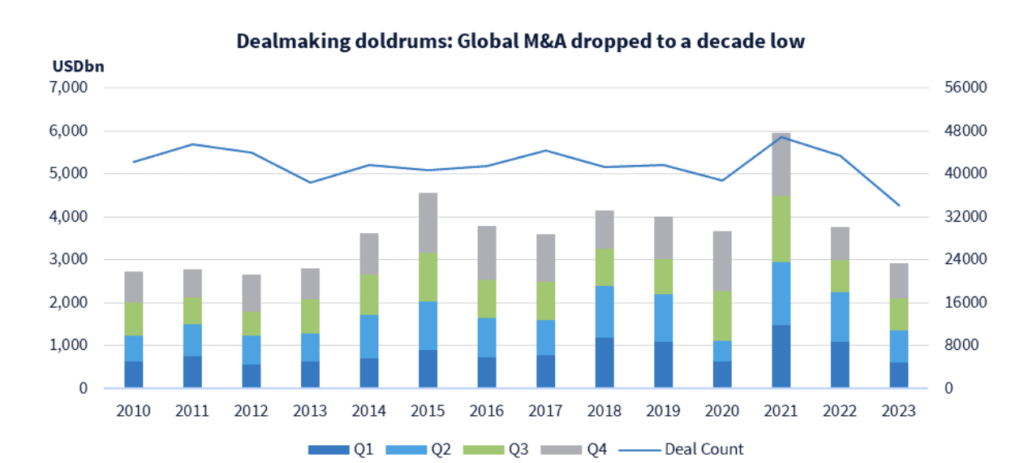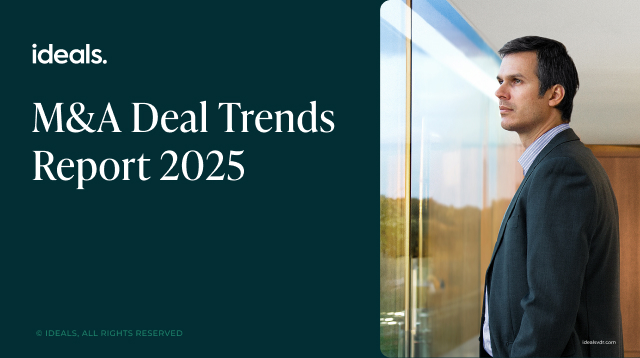To respond to market complexity, many executives turn to mergers and acquisitions (M&A) as an effective transformation and value-generation strategy.
With this in mind, the M&A Community is producing a series of articles to support business owners and executives in taking the first steps towards beneficial deals and helping individuals around the globe capture benefits beyond the expected synergies.
The world has seen lots of successful mergers and acquisitions cases. Big and famous mergers are always a great source of inspiration and a chance to learn from. Let’s discover the best and biggest (either by the deal size, strategic importance, or impact on the industry) examples of mergers and acquisitions.
Additionally, we’ll take a brief look at the general tendencies in the 2024 M&A market. Read on to explore!
Overview of the biggest M&A deals for the last 7 years (2017-2023)
Since 2010, about 500,000 merger and acquisition deals have been concluded globally.
Starting from 2016, the overall number of M&A deals fluctuated slightly, but, by the end of 2021, it drastically increased to 63,000.
In 2021, the overall value of worldwide mergers and acquisitions in business amounted to almost six trillion dollars.
Let’s go through the most memorable international acquisitions of the last 7 years that made it and where post merger integration proved to be successful.
Five biggest M&A deals in 2017
- Linde AG and Praxair, $80 billion
Linde AG is a chemical company that specializes in producing and distributing atmospheric gases and was started in Germany. Praxair was one of the biggest American global industrial gas companies. The main reason for the merger of these two firms was the desire of the buy side vs. sell side to resolve the competition concerns in Canada. The successful Linde AG and Praxair merger would lessen the competition in a supply chain. As a result of the proposed merger, a combined company appeared — Linde plc. This merger of equals is considered one of the largest and most successful M&A deals, costing about $80 billion.
- CVS Health and Aetna, $70-billion
The $70-billion merger of Aetna and CVS Health resulted in the new healthcare giant. The Aetna acquisition created new business prospects for the CVS Health corporation as well as for the merged company. Through a vertical merger, these two companies aimed to transform the customer healthcare experience, combining health insurance and pharmacy services in one. And though many M&A business experts find this transaction questionable since customers might not welcome the higher healthcare costs, it’s still one of the most successful M&A examples.
- British American Tobacco and R. J. Reynolds Tobacco Company, $49 billion
To increase the market presence and customer base, British American Tobacco acquired the remaining 57.8% of Reynolds American Inc. With the $49 billion deal closed, the holding company increased cash flows and built a stronger financial profile. Target company’s shareholders received for each Reynolds share $29.44 in cash. British American Tobacco and R.J. Reynolds Tobacco Company merger is considered one of the biggest deals in history not only because of its price but also because of such big brands combined as Camel, Lucky Strike, and Pall Mall.
- United Technologies and Rockwell Collins, $30 billion
United Technologies and Rockwell Collins merger is definitely one of those Wall Street Journal cases. After the United Technologies (UTC) company has received all the regulatory approvals to buy Rockwell Collins, it resulted in one of the biggest company acquisitions in the aerospace manufacturing industry. This successful merger allowed the new entity to broaden the customer market and increase cash flows by making the aerospace industry booming. The full value of the deal is about $30 billion.
- Shenhua Group and China Guodian Corporation, $278 billion
This deal is one of the biggest acquisitions in China. Shenhua Group was the largest coal provider in China, and China Guodian Corporation is one of the five largest electricity producers. After the government and investors approved this integration, it kicked off the formation of the combined entity, which was expected to become the largest power company by capacity in the world. The deal closed with $278 billion of combined assets.
5 biggest M&A cases in 2018
- Energy Transfer Equity and Energy Transfer Partners,$90 billion
Energy Transfer Equity and Energy Transfer Partners merger aimed to simplify the overall structure of the new company, as well as increase cash distribution coverage and improve the integrated company’s cost of capital. The combined value of one company that occurred after the merger was estimated to be $90 billion.
- The Walt Disney Company and 21st Century Fox, $71.3 billion
The $71.3-billion deal between Walt Disney Company and 21st Century Fox allowed the acquiring company (Walt Disney) and the target company (21st Century Fox) to unite their assets to gain a higher market value and presence. This transaction is considered one of the largest mergers in the global media industry for the last 50 years. By the time of the integration, The Walt Disney Company and 21st Century Fox already covered almost 90% of media output. Their horizontal merger only increased that rate.
- Takeda Pharmaceutical and Shire plc, $62 billion
Takeda Pharmaceutical is the largest pharmaceutical company in Asia, with headquarters in Japan. Shire plc was a US-based biopharmaceutical company with a great market presence in the United States. The eight-month-long acquisition deal between Takeda Pharmaceutical and Shire plc allowed Takeda to expand its geographic influence and, thus, increase its revenue and cash flows. This is Japan’s largest merger with a foreign company and one of the most interesting M&A deals of 2018, with a deal value of $62 billion.
- Comcast Corporation and Sky plc, $39 billion
Comcast Corporation and Sky plc are both telecommunications companies operating in slightly different markets — the United States and Europe. The $39 billion acquisition of Sky plc enabled Comcast Corporation to reduce competition and gain a better market presence. Lots of M&A experts believed that Comcast Corporation overpaid Sky plc. However, as a result, Comcast holds 75% of Sky’s share capital.
- ChemChina and Sinochem
The deal between ChemChina and Sinochem is considered one of the largest mergers in the chemical industry. ChemChina and Sinochem are both Chinese state-controlled companies. The reason for integration was mainly the consolidation of the agricultural assets, which would significantly increase the revenue. This resulted in a larger company named Syngenta Group, which is expected to become the innovation-driven leader in the market.
The bigger doesn’t always mean success. Learn why mergers and acquisitions fail and how to avoid the most typical M&A challenges in our dedicated article.
5 biggest mergers and acquisitions in 2019
- United Technologies and Raytheon, $135 billion
The successful merger of United Technologies and Raytheon is a great example of corporate acquisitions, as it kicked off the creation of the most advanced aerospace and defense systems producing company in the world. The main reason for the merger was the elimination of competition in supply, which would allow the merging companies to improve their market presence and increase revenue. The deal was closed at $135 billion.
- Bristol-Myers Squibb and Celgene, $74 billion
Bristol-Myers Squibb is a US-based multinational pharmaceutical company and one of the world’s largest pharmaceutical companies, with total revenue of almost $47 billion. Celgene is also an American pharmaceutical company that specializing mainly in immunology and cancer drugs. The $74-billion deal between these two corporations became one of the largest mergers in the pharmaceutical industry and gave the start to a global biopharma company with a focus on oncology and immunologic diseases.
- Saudi Aramco and SABIC, $69.1 billion
Saudi Aramco acquired 70% of the target business, Saudi Basic Industries Corporation (SABIC), from the Public Investment Fund (PIF). The total purchase price was estimated at $69.1 billion. This transaction allowed Saudi Aramco to strengthen its presence in the global petrochemicals market and increase the oil demand among customers, which resulted in greater efficiency. The deal is often referred to as one of the largest mergers in the history of Saudi Arabia.
- Abbvie and Allergan plc, $63 billion
Abbvie acquired Allergan plc, the second-largest drug company in the market, for $63 billion. The companies that merged aimed to create a biopharmaceutical corporation with top positions in the market in such areas as hematologic oncology, immunology, and neuroscience. This merger allowed Abbvie to diversify its assets portfolio, resulting in long-term growth.
- Groupe PSA and Fiat Chrysler, $52 billion
The Groupe PSA and Fiat Chrysler merger came with splitting profits for both companies. PSA gained access to the American market, and Fiat Chrysler could reach PSA’s newer manufacturing facilities. This resulted in a new automobile company named Stellantis, which became the fourth-largest manufacturer by volume in the world. The deal was closed at $52 billion.
5 biggest merger and acquisition examples in 2020
- Unilever plc and Unilever N.V., $81 billion
Unilever plc acquired Unilever N.V. for $81 billion. The main reason for this merger was the company’s unification, resulting in a simplified legal structure, improved governance, and greater strategic flexibility. By the end of the deal, there was a single parent company — Unilever plc.
- Nippon Telegraph and Telephone and NTT Docomo, $40 billion
This merger and acquisition deal is considered one of the big mergers in the Japanese telecommunications industry. Nippon Telegraph and Telephone purchased the NTT Docomo for $40 billion. The companies aimed to cut prices through combined facilities and manufacturing. And since it’s a state-owned business, it would stimulate consumer spending elsewhere in the Japanese economy.
- AstraZeneca and Alexion Pharmaceuticals, $39 billion
AstraZeneca and Alexion Pharmaceuticals are both giants in the pharmaceutical market. The announced AstraZeneca’s $39-billion acquisition of Alexion Pharmaceuticals was promised to strengthen the combined company’s market presence and conquer more customers in the market. The expected outcome was to develop new medicines in the area of immunology and, thus, increase the cash flow.
- Liberty Global and Telefónica, $38 billion
In May, the British units of Liberty Global and Telefónica announced their joint venture. This transaction is expected to achieve £700 million in synergies. The goal was to integrate Telefónica’s British mobile operator O2 and Liberty’s Virgin Cable network company. The deal value was estimated at $38 billion.
- Salesforce.com and Slack Technologies, $28 billion
Salesforce acquired Slack for about $28 billion in December 2020. The main goal of this merger was to create a unique and highly technological ecosystem that would allow the combined entity to strengthen its market presence, gain access to new customers, and increase revenue and cash flows.
5 biggest mergers and acquisitions in 2021
- BHP Group Limited and BHP Group plc.
This deal is often considered the largest merger of 2021 in Australia. The simple reason for the integration of BHP Group Limited and BHP Group plc was the unification and formation of one strong mining corporation in the Australian market. This allowed the company to simplify the corporate structure and gain greater strategic flexibility, which is expected to result in a stronger portfolio and new growth possibilities.
- Discovery Inc. and AT&T (United States WarnerMedia), $43 billion
This deal is a good example of large recent company mergers in the media industry. Discovery Inc. acquired the WarnerMedia business for $43 billion. This transaction allowed companies to create the world-strongest media portfolio of content. Now, entertainment movies and education content are distributed under one brand, which gives the company new growth opportunities, strengthens its market presence, and increases the share value.
- Canadian Pacific Railway and Kansas City Southern, $31 billion
Canadian Pacific Railway purchased Kansas City Southern for $31 billion. This integration allowed the two companies to create the first direct railway that links Canada, the United States, and Mexico. Thus, this deal is expected to expand the company’s market share and revenue.
- Oracle Corporation and Cerner Corporation, $28.4 billion
The software-producing corporation Oracle announced the acquisition of the health IT company Cerner in 2021, but the deal was officially finalized only in June 2022. The estimated merger value is $28.4 billion. This combination allows Oracle to expand its influence in the healthcare industry by producing more healthcare products. Considering the fact that healthcare is now the largest and the most important vertical market in the world, this transaction is a perfect example of how a business can increase its revenue.
- Square Inc. and Afterpay, $29 billion
The merger and acquisition deal between an American financial services company and an Australian financial technology company was closed at $29 billion. The key reason for this transaction was the desire of both businesses to share the technology. It would allow them to produce even more financial services, and, thus, cover a broader range of customers’ needs, which inevitably leads to increased cash flows and revenue.
5 biggest examples of mergers in 2022
- Microsoft and Activision Blizzard, $68.7 billion
At the beginning of 2022, Microsoft announced its plans to acquire Activision Blizzard, an American leading video games provider. The deal’s value is estimated at $68.7 billion. With this acquisition, Microsoft plans to boost its growing metaverse strategy and accelerate the company’s growth in the gaming business across console, PC, and mobile devices.
- Broadcom Inc. and VMware, $61 billion
In May 2022, Broadcom Inc. announced its acquisition of VMware company at an estimated value of $61 billion. By the closure of this transaction, Broadcom will rebrand and operate under VMware. The expected results of the deal are accelerated innovation, enhanced production, and increased revenue.
- Prologis and Duke Realty, $26 billion
In October 2022, Prologis announced its all-stock acquisition of Duke Realty Corporation. The reason behind the acquisition was an opportunity for Prologis to expand its presence in the main US markets. The deal was valued at nearly $26 billion, including the assumption of debt. As a result of the Prologis and Duke Realty merger, a new legal entity appeared and created an outstanding portfolio of logistics properties.
- HDFC Bank and Housing Development Finance Corporation Limited, $40 billion
India’s leading private sector bank, HDFC Bank, has announced its acquisition of the Housing Development Finance Corporation Limited, India’s biggest mortgage lender, in April 2022. The all-stock transaction was completed in July 2023, after a 15-month merger process. The deal created the fourth-largest lender in the world by market capitalization, behind such giants as JPMorgan Chase, Industrial and Commercial Bank of China, and Bank of America.
- Kroger and Albertsons, $24.6 billion
Rival grocery stores Kroger and Albertsons announced their plans to team up in October 2022.
Together, the companies are about to form the second-largest grocer by market share in the US (after Walmart). The definitive agreement of the deal was unanimously agreed upon by the stakeholders of both companies and requires regulatory approval.
Note: To learn more about 2022 M&A trends, read our dedicated article.
5 biggest M&A examples in 2023
- ExxonMobil and Pioneer Natural Resources, $60 billion
In October 2023, ExxonMobil, one of the world’s largest oil and gas companies, announced that a company purchases rival Pioneer, a Texas-based company that’s engaged in hydrocarbon exploration. The deal is an all-stock transaction that’s valued at almost $60 billion and $253 per share. This is the biggest deal for ExxonMobil since Saudi Aramco. As a result, a merged company is expected to have the largest oil and gas production in the Permian Basin.
- Pfizer and Seagen, $43 billion
In March 2023, Pfizer, an American multinational pharmaceutical and biotechnology corporation, announced its acquisition of Seagen, a global biotechnology company, for a total value of $43 billion, or $229 per each Seagen share. With this deal, which is the largest in the healthcare industry since 2019, Pfizer plans to improve the ways of battling cancer.
- Chevron and Hess, $53 billion
Chevron is an American multinational energy corporation that specializes mainly in oil and gas. Hess is also an energy company that’s involved in the production and exploration of natural gas and crude oil. In October 2023, the companies announced that they were entering into a definitive agreement and Chevron purchased Hess in an all-stock transaction estimated at $53 billion. With this deal, Chevron will upgrade and diversify its portfolio and also gain a stake in rival ExxonMobil’s Guyana discoveries, which will help the company to get a bigger oil footprint in the US market.
- Cisco and Splunk, $28 billion
In September 2023, a technology company Cisco announced that it acquired Splunk, a California-based software company that specializes in cybersecurity. The deal is estimated at $28 billion — $157 for each Splunk’s share in cash. With this transaction, both companies involved aim at increasing their cybersecurity measures, which will help to enhance their clients’ digital resilience.
- Bunge and Viterra, $34 billion
In September 2023, Bunge, the US agribusiness and food company, announced its acquisition of Viterra, the Canadian grain handling company. This stock and cash transaction is estimated to gain advantages from increased operational flexibility throughout the oil seed and grain supply chains and processing, enhanced resources, and the collaborative talent of employees to foster innovation and meet customer needs in various settings, generating value for all stakeholders.
For more record-breaking deals, don’t miss our insight on the biggest mergers and acquisitions of all time.
Future M&A outlook for 2024
Now, let’s briefly take a look at what the M&A industry is expected to look like in 2024 according to M&A experts and practitioners.
Though the total value of M&A deals dropped significantly in 2023 and reached the lowest level since 2013, the deals were still done. What’s more, the Q4 showed some signs of recovery, Morrison & Foerster states, especially in such industries as technology and oil and gas.

Based on our experience, this could also be a sign of a certain recovery of M&A activity in 2024 as well. Let’s review the main factors that speak about that.
Key drivers for M&A activity surge in 2024
As mentioned by Boston Consulting Group and drawing from our observations, the global M&A activity has a chance for a new burst because of the following factors:
- Dry powder reserves
For now, there’s an abundance of available capital among private equity and venture capital investors, independent wealth funds, and large companies. This could speak about the possible usage of that capital for potential investments in the coming year.
- Matching price expectations
During the last few years, the difference between the sellers’ and buyers’ price setting was one of the main reasons for a stagnation in deal-making. This was because of many factors that largely impacted pricing: from high inflation levels to global economic and geopolitical uncertainty. However, sellers are not starting to accept the new normal and adjusting to the current environments, which, in turn, can lead to the gap between sellers’ and buyers’ pricing expectations narrowing down.
- Evolving regulations and policies
Changes to the general regulations and policies have always impacted M&A deal-making. Traditional antitrust regulations often complicate large deals, especially in the technology sector. Additionally, dealmakers have to overcome challenges that are related to national security considerations or foreign direct investment regulations. On the other hand, deals that are conducted under antitrust scrutiny often encourage divestitures as a defense against these challenges.
- Resilience pursuit
In a time of global economic uncertainty and geopolitical tensions, companies are looking for ways that could enhance the resilience of their business operations. This, for example, relates to supply chain resilience, which could be improved through near-shoring or friend-shoring M&A strategies.
Key takeaways
Let’s briefly summarize the main takeaways from the article:
- Since 2010, about 500,000 M&A deals have been conducted worldwide.
- The peak of global M&A activity was in 2021 when the overall value of worldwide mergers and acquisitions amounted to almost six trillion dollars.
- Among the biggest examples of mergers and acquisitions during the last 7 years are ChemChina and Sinochem ($120 billion), United Technologies and Raytheon ($135 billion), Unilever plc and Unilever N.V. ($81 billion), and Microsoft and Activision Blizzard ($68.7 billion).
- The largest merger of all time is a $202.8 billion deal between Vodafone and Mannesmann that took place in 1999.
- Despite the drastic decline in M&A activity in recent years, deal-makers anticipate its surge in 2024.



